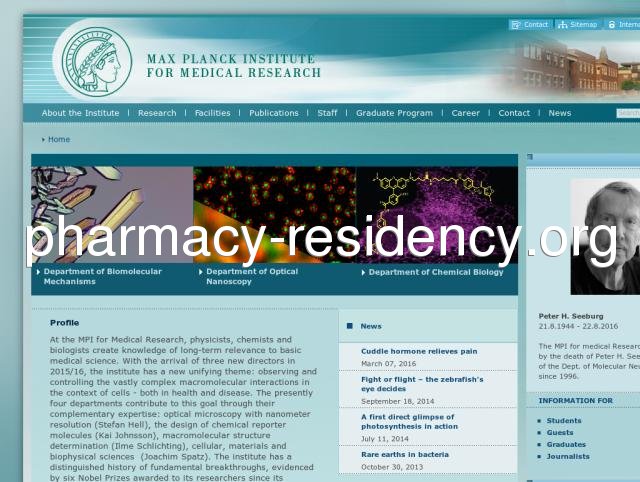www.mpimf-heidelberg.mpg.de Review:
Home | Max Planck Institute for Medical Research - The institute was opened in 1930 as the Kaiser Wilhelm Institute for Medical Research, and was re-founded as a Max Planck Institute in 1948. Its original goal was to apply the methods of physics and chemistry to basic medical research, and it included departments of Chemistry, Physiology, and Biophysics. In the 1960s, new developments in biology were reflected with the establishment of the Department of Molecular Biology. Toward the end of the 1980s and during the 1990s, investigations began into the specific functions of muscle and nerve cells. New departments were established in Cell Physiology (1989), Molecular Cell Research (1992-1999), Molecular Neurobiology (1995), Biomedical Optics (1999) and Biomolecular Mechanisms (2002). The independent junior research groups for Ion Channel Structure (1997-2003) and Developmental Genetics of the nervous System (1999) were also founded. Since its foundation, five Nobel Prizewinners have worked at the institute: Meyerhof (Physiology), Kuhn (Chemistry), Bothe (Physics), Mößbauer (Physics) and Sakmann (Physiology or Medicine). The institute currently has three departments and two independent junior research groups. The Department of Molecular Neurobiology focuses on the analysis and altering of mouse genes that are responsible for rapid signaling in the brain; the purpose is to investigate which brain capacities are inherited and which are learned. The Department of Biomedical Optics studies the activity of groups of nerve cells in tissue preparations and in laboratory animals with the use and continued development of multiquantum microscopy. The research in the Department of Biomolecular Mechanisms is aimed at establishing the molecular basis of model reactions, using the methods of biophysics and structural biology.
Country: 134.76.31.205, Europe, DE
City: 9.9333 Lower Saxony, Germany
Bought the sport model. Looks nice with the 19 inch wheels and lip spoiler. Good ride with lots of interior room. Good mpg on my first trip with it.
Not use to this format, I have all ways used street atlas - Will give it more time and see how things turn out
Why in the sweet lord's name does this game require an internet connection to play at all.... lunacy. Nice launch day, guys. Real slick.
Best floss in the market with great flavor choices and fantastic access with the design of the floss. Will never use any other floss. Thank you Cocofloss and my hygienist will thank you, too.
Awesome service and awesome product. This is one of the best foundations that I have ever used. The coverage is awesome for redness just like it suggests and doesn't look cakey!!
This cup is fabulous! I purchased a Starbucks coffee, which I drink every morning and dumped it into this cup. After one hour it was still hot-hot. After two hours it was still very warm. After three hours it was luke warm but not near cold. Coffee wouldn't typically last me that long but I was purposefully testing it out. The lid seals tight and it's easy to grip... I do wish it was a tad bit smaller and had a slide close on top so I could double it as a soup thermos for my kids who take lunches to school... I will be looking for them to come out with that next ☺️
I got this blender for my wife for Christmas. She always hated how our cheap, $50 blender couldn't handle ice when making smoothies. I didn't know anything about the Ninja, but it seemed to be gaining a lot of popularity so I decided to look into it. The thing that really sold me on this blender was simply the fact that it could handle ice like it's nothing at all (it can quite literally turn ice into snow in a matter of seconds) and even though I wanted a Vitamix, I just couldn't justify spending $400+ if this blender could do what we wanted it to do.
